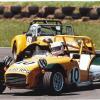A couple of things missing from the article linked above:
* Fireproof bulkheads were "mandatory" at some events/categories in the 1950s. Interpretation of the requirement varied, with the most strict being that the driver was in a fuel-free metal box with an open lid. Even so, saddle tanks over the drivers' legs were adopted for races when fuel capacity required.
* Jackie Stewart taped a spanner to the steering wheel so that it could be removed following an accident.
* Deformable structures along the side of F1 cars were required from the early/mid 1970s.
* External projections from cars were restricted in size (eg Lotus 49 exhausts).
* Use of magnesium alloys has been restricted to bulk items (eg uprights) rather than monocoque skins and small components. I don't know how much this was driven by regulations or engineering common sense.
* Early applications of carbon fibre were often misguided (eg Hill carbon fibre wing support) and designers were initially very cautious when creating monocoques from it. Lotus added Kevlar to their first composite monocoque and McLaren (with partners) conducted a thorough design analysis for their version. When was crash testing introduced?
* Louis Stanley established a mobile first aid service to attend grands prix. Doctors offered their services to something that would make a difference.
* Crack testing, X-ray analysis, component life records, manufacturing quality etc have improved enormously. They make a more significant difference regarding historic racing.
It is worth noting that many of the positive safety changes were introduced by participants (drivers, organisers, engineers) before racing regulators considered them.





















